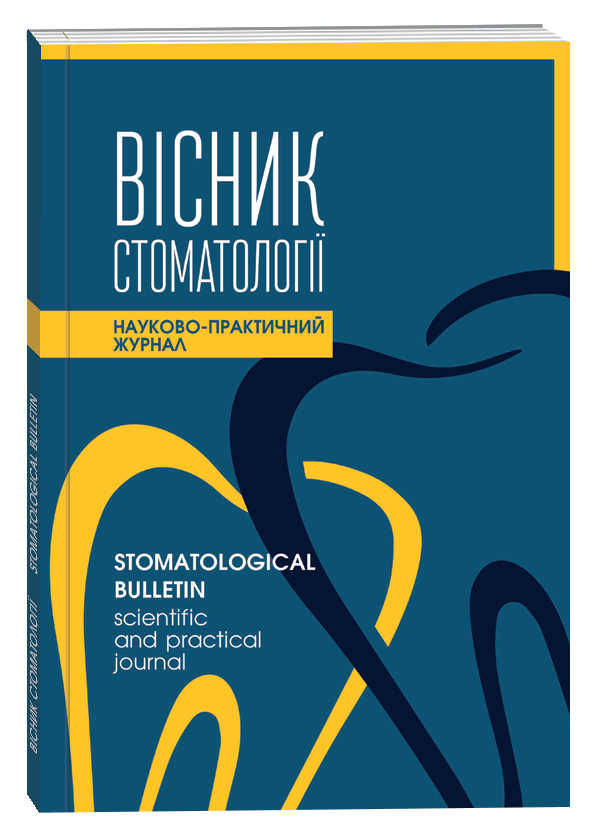DESTABILIZATION OF THE TAXONOMIC COMPOSITION OF MICRO-ECOLOGICAL INDICATORS OF THE «MACROORGANISM – MICROBIOME» ECOSYSTEM THE MICROBIOTA OF THE ORAL CAVITY OF PATIENTS WITH CHRONIC LACUNAR ANGINA
DOI:
https://doi.org/10.35220/2078-8916-2022-45-3.23Keywords:
adult patients, lacunar angina, oral cavity, microbiome.Abstract
The aim of the study. Study of the taxonomic composition, microecological indicators of the «macroorganismmicrobiome » ecosystem, oral microbiota, immunosuppressive properties of leading taxons of opportunistic microbiota in adult patients with chronic lacunar angina. Research methods. The conducted research made it possible to establish that in adult patients, the destabilization of the oral microbiota occurs due to the contamination of the S. aureus and S. pyogenes biota with changes in the main, additional and accidental microbiota. Random opportunistic microbiota exhibit immunosuppressive activity, and the main representatives exhibit antiphagocytic and antilysozyme activity, the level of which depends on the taxon. The antibiotics of choice are ofloxacin, gatifloxacin, ciprofloxacin, etc. Scientific novelty. The study of the destabilization of the state of the oral microbiome of adult patients, as well as the main indicators of the "macroorganism-microbiome" ecosystem of the microbiota of the oral cavity during lacunar angina in adults is relevant and necessary both for the diagnosis and for the therapy of adult patients with lacunar angina. Conclusions. With chronic lacunar angina in adults, destabilization of the microbiota of the oral cavity occurs due to S. aureus (instead of S. salivarius) and S. pyogenes (instead of S. sanguis). In addition, opportunistic microbiota colonize the biotope (S. pneumoniae, P. aeruginosa, E. coli, E. cloacae, S. marcescens) and exhibit immunosuppressive activity. In turn, S. pyogenes, S. aureus, H. Influenzae show antiphagocytic activity, the level of which depends on the taxon, and the highest level of antilysozyme activity is shown by S. mitis. Bacteria of the genus Streptococcus (S. pyogenes, S. anginosus, S. mitis), Staphylococcus (S. aureus), Haemophilus (H. influenzae), Prevotella (P. loescheii) and Peptococcus (P. magnus) inhibit the phagocytic activity of peripheral blood neutrophil granulocytes in the first phases of phagocytosis.
References
Сидорчук, Л. І., Міхєєв, А. О., Гаврилюк, О. І., Джуряк, В. С., & Сидорчук, І. Й. (2022). Особливості дестабілізації мікробіома порожнини рота за лакунарної ангіни в дітей. Вісник стоматології, 118(1), 97-102.
Маслянко, Р. П., & Божик, Л. Я. (2011). Деякі питання персистенції мікроорганізмів в інфекційній патології. Науковий вісник Львівського національного університету ветеринарної медицини та біотехнологій імені С.З. Ґжицького, 13(4-1 (50)), 257-261.
Скрипников, П. М., Силенко, Г. М., Силенко, Б. Ю., Хребор, М. В., & Сидорова, А. І. (2014). Фактори гомеостазу ротової порожнини в нормі та при дефіциті секреторного IgA. Український стоматологічний альманах, (2), 73-75.
Менкус, О. В. (2012). Вивчення антилізоцимної активності бактерій родів Streptococcus та Staphylococcus, виділених від пацієнтів із захворюваннями органів дихання. Вісник Харківського національного університету імені В.Н. Каразіна. Серія: Біологія, (15), 187-191.









